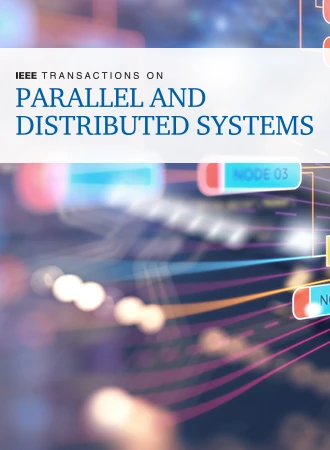探索分布式并行稀疏矩阵-多矢量乘法的设计空间
IF 5.6
2区 计算机科学
Q1 COMPUTER SCIENCE, THEORY & METHODS
IEEE Transactions on Parallel and Distributed Systems
Pub Date : 2024-08-30
DOI:10.1109/TPDS.2024.3452478
引用次数: 0
摘要
我们考虑的是稀疏矩阵与密集矩阵的分布式内存并行乘法(SpMM)。稠密矩阵通常是稠密向量的集合。标准实现方法会同时用稀疏矩阵与多个稠密向量相乘,以利用其中的计算效率。但这种方法通常使用的稀疏矩阵分区与单个向量相乘的方法相同。本文探讨了 SpMM 并行化的设计空间,并表明较粗粒度的矩阵划分与按列划分的向量块相结合,往往能减少通信量,实现更高的 SpMM 性能。本文提出了一种算法,可为给定数量的进程选择进程网格几何形状,以优化并行 SpMM 性能。该算法可以利用多个密集向量相乘时的额外并发性,进一步减少通信量,从而增强现有的图分割器。本文章由计算机程序翻译,如有差异,请以英文原文为准。
Exploring the Design Space of Distributed Parallel Sparse Matrix-Multiple Vector Multiplication
We consider the distributed memory parallel multiplication of a sparse matrix by a dense matrix (SpMM). The dense matrix is often a collection of dense vectors. Standard implementations will multiply the sparse matrix by multiple dense vectors at the same time, to exploit the computational efficiencies therein. But such approaches generally utilize the same sparse matrix partitioning as if multiplying by a single vector. This article explores the design space of parallelizing SpMM and shows that a coarser grain partitioning of the matrix combined with a column-wise partitioning of the block of vectors can often require less communication volume and achieve higher SpMM performance. An algorithm is presented that chooses a process grid geometry for a given number of processes to optimize the performance of parallel SpMM. The algorithm can augment existing graph partitioners by utilizing the additional concurrency available when multiplying by multiple dense vectors to further reduce communication.
求助全文
通过发布文献求助,成功后即可免费获取论文全文。
去求助
来源期刊

IEEE Transactions on Parallel and Distributed Systems
工程技术-工程:电子与电气
CiteScore
11.00
自引率
9.40%
发文量
281
审稿时长
5.6 months
期刊介绍:
IEEE Transactions on Parallel and Distributed Systems (TPDS) is published monthly. It publishes a range of papers, comments on previously published papers, and survey articles that deal with the parallel and distributed systems research areas of current importance to our readers. Particular areas of interest include, but are not limited to:
a) Parallel and distributed algorithms, focusing on topics such as: models of computation; numerical, combinatorial, and data-intensive parallel algorithms, scalability of algorithms and data structures for parallel and distributed systems, communication and synchronization protocols, network algorithms, scheduling, and load balancing.
b) Applications of parallel and distributed computing, including computational and data-enabled science and engineering, big data applications, parallel crowd sourcing, large-scale social network analysis, management of big data, cloud and grid computing, scientific and biomedical applications, mobile computing, and cyber-physical systems.
c) Parallel and distributed architectures, including architectures for instruction-level and thread-level parallelism; design, analysis, implementation, fault resilience and performance measurements of multiple-processor systems; multicore processors, heterogeneous many-core systems; petascale and exascale systems designs; novel big data architectures; special purpose architectures, including graphics processors, signal processors, network processors, media accelerators, and other special purpose processors and accelerators; impact of technology on architecture; network and interconnect architectures; parallel I/O and storage systems; architecture of the memory hierarchy; power-efficient and green computing architectures; dependable architectures; and performance modeling and evaluation.
d) Parallel and distributed software, including parallel and multicore programming languages and compilers, runtime systems, operating systems, Internet computing and web services, resource management including green computing, middleware for grids, clouds, and data centers, libraries, performance modeling and evaluation, parallel programming paradigms, and programming environments and tools.
 求助内容:
求助内容: 应助结果提醒方式:
应助结果提醒方式:


